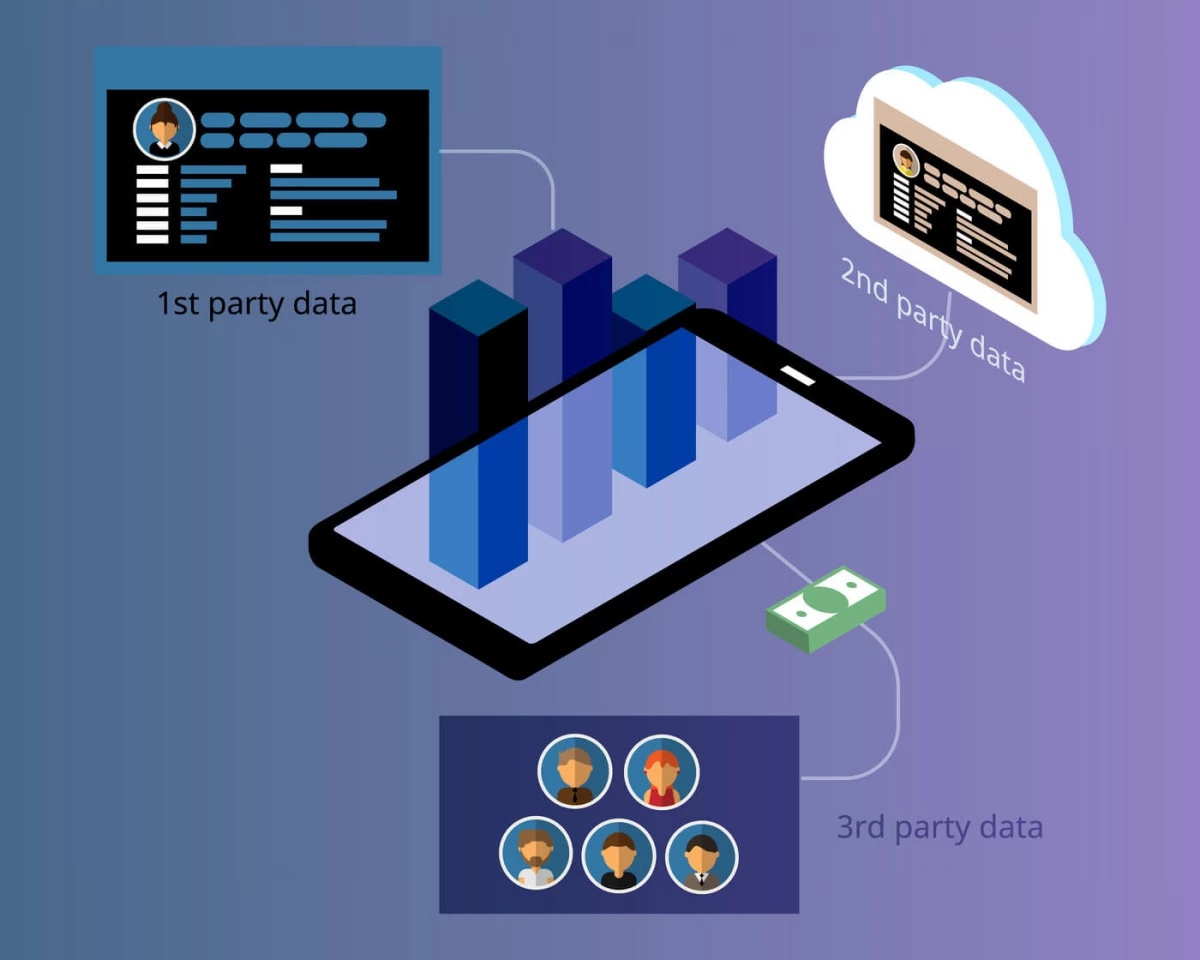Are you still leaning into third-party cookies to optimize your media buying strategies? Google may have backed off its cookie deprecation plan, but other browsers (Mozilla and Safari) have already implemented changes.
First-party data audiences are more relevant to advertisers’ customers and perform better. The sooner you take the reins of your first-party data collection, the more quickly you can have confidence in your audience marketing.
What is First-Party Data?
First-party data, 1P, 1PD, or whatever you call it, refers to customer data collected via your owned channels. Examples of first-party data can include names, addresses, email addresses, website history and activity, interests, and behaviors.
Other data types and sources may include some of those data points, but they aren’t likely to include all of them.
The data is unique because you own it; you know where the information came from. It’s high quality, relevant, safe, and accurate, assuming you followed the privacy and consent regulations (we’ll go into that later).
Other Types of Data in Marketing
For clarity, let’s go into those other data types, starting with third-party.
- Third-party data is aggregated by an external organization that collects data from multiple sources and consolidates it to share or sell. These data sets are sometimes considered to be any data received from an external organization. The information in these lists is not always high-quality, relevant, or accurate, and you have no guarantees that the information was received under the current privacy and consent guidelines. Third-party data does have its benefits. It helps you reach a much larger audience than the smaller data set you have collected in-house. That reach can also help you improve targeting when combined with your internal data. 3PD is most often purchased and can only be used programmatically.
- Second-party data is less common and comes from a partner you trust, not just from a list you buy. In theory, you know the quality of the data, and it’s often used in a mutually beneficial manner, like a co-marketing project or other marketing data strategy. Even when data comes from a trusted partner, marketers should do their best to ensure it is privacy-compliant and acquired with consent. Second-party data can also be combined with your 1PD, but like your own data, make sure to clean the lists before using them.
- Zero-party data is another example of the marketing industry creating names for categories that may not need to exist. Customers voluntarily provide zero-party data through your first-party data platforms. You might ask why that is not first-party data, and that would be a great question. Some believe it shouldn’t exist since it’s included in first-party data. Those who prefer to use both category names break out the information captured by owned channels. Zero-party data doesn’t necessarily include website activity, interests, or purchase behaviors; it is solely the specific contact information, like name, address, phone number, and email. It can also be defined by the direct information contacts give you, not the data you collect from their actions. For instance, if they fill out a form, that would be zero-party data. First-party data would be what you see in GA4 or your CRM/CDP about their actions before and after filling out that form.

The Benefits of Using First-Party Data in Marketing Campaigns
The accuracy and reliability of first-party data in advertising allow marketers to reach the right audience with the right messages, leading to higher engagement.
First-party data benefits include audience segmentation by location, age groups, purchase history, and many other categories. This allows for more personalization in advertising and marketing interactions. It also helps you guide your audience through the sales funnel. Personalized connections with your prospects build trust, relationships, loyalty, and brand reputation.
This eliminates dependency on costly and less successful external sources. It offers improved ROI and can reduce ad spend waste. First-party data is also valuable in retargeting and reactivation campaigns.
When first-party data is collected and managed correctly, it follows privacy compliance and meets CPRA and/or GDPR (depending on your location, business type, and reach). With these benefits, a first-party data strategy becomes key for advertising and marketing programs.
Challenges of First-Party Data and How to Overcome Them
There are many reasons we relied on third-party data for so long. 1PD is not easy. It requires clear, transparent, and accessible communication about your data collection, use, and management. There can be many challenges in collecting and using first-party data.
The complexity of your first-party data management is why, in an article from Harvard Business Review, they shared that only 26.5% of organizations identify as data-driven organizations. From the same study, 92% of executives believe cultural obstacles are the biggest barrier to being data-driven. They believe the issue is more about people, processes, and communication than technology.
Your organization should build a first-party data analytics strategy and tech stack for data integration across channels, possibly using a CDP (Customer Data Platform) for unified insights, effective collection, and management.
First-party data compliance with privacy regulations is vital. You need a data governance plan outlining how you collect information, the protection regulations you have implemented, and how you follow CPRA or GDPR.
How to Collect and Manage First-Party Data for Advertising.
Here are some examples of first-party data collection methods for advertisers:
- Website Analytics: Tracking visits, behaviors, and conversions through tools like GA4 connected to your website.
- Loyalty Programs: Encouraging sign-ups and engagement.
- Email & Text Opt-ins: Capturing subscriber data through gated content.
- Surveys & Interactive Content: Gathering zero-party data insights.
- In-App & Purchase Data: Leveraging e-commerce interactions.
These are just a few channels marketing can use to collect prospect and customer data. Ideally, this data feeds into a CRM or CDP and builds audience profiles with every data point captured and activity created.
But do you know what data other departments in your organization are collecting that may be useful for marketing, or are your departments working in silos?
Accounting has its own collection processes and data platforms for your vendors and customers. Is that data connecting with marketing records to add to your customer profiles? IT, Operations, and Sales may also have their own collection and management processes. If you’re a business with retail locations or satellite offices, are they all connected as well?
Even if your marketing department has “consent compliance” in place, do you know if your other departments do as well, especially if you are connected to their data sets? Collecting and managing first-party data takes a team of department leaders along with research, technology, communication, implementation, access management, governance, review processes, and protections.
If you aren’t already collecting first-party data or are but don’t have protected systems in place, now is the time to start. It can be overwhelming, and we know everything falls on marketing, but it does take one person to raise the flag and begin the process.
Start small. Review how your department collects data, what it is, and where it is going. This is a must.

Examples of First-Party Data Usage in Marketing
Once you have reviewed and optimized your first-party data collection and management strategy throughout your organization, you can focus on capturing as many data points as possible across multiple channels.
- Collect contacts through email subscriptions and then use email marketing to engage more deeply with those contacts.
- Advertising reaches prospects who visit your website and complete a form. This adds to your 1PD and allows you to retarget or reactivate those visitors.
- Customize loyalty program messaging and promotions based on past purchases.
- Show web users location-based ad content based on their previous data shared through your owned channels.
Best Practices for Leveraging First-Party Data in Ad Targeting
Build comprehensive customer profiles to leverage your data for ad targeting:
- Audience Segmentation: Create precise customer groups for targeting
- Personalization Strategies: Deliver tailored messaging and offers
- Retargeting: Re-engage prospects
- Lookalike Audiences: Scale first-party data to reach similar audiences
- Cross-Channel Advertising: Integrate data across social, display, and email campaigns
- Predictive Analytics & AI: Enhance campaign effectiveness through machine learning
What’s Next for First-Party Data?
Like many aspects of business, the future of advertising and marketing will be in AI and first-party data. AI will make collection and personalization easier. Filtering and segmentation will take less manual work. Clean rooms will allow you to collaborate with other data sources safely while getting the full benefit of the consolidation.
First-party data is the new King of marketing. Collecting, managing, and using it correctly will benefit brands and advance advertising results. I predict a time when marketers will be surprised to learn that we ever used random data purchased from outside their organization, not knowing where it came from, how accurate it was, or whether the contacts gave consent.
That time may be sooner than you think. Now is the time to build your first-party data strategy. If you have already started and are looking for guidance on how to use your datasets for advertising, work with a media-buying professional who can maximize the value of your data.
Additional Sources:
https://www.onetrust.com/resources/ultimate-guide-to-first-party-data-ebook/
https://www.storyly.io/post/pr...
https://cdp.com/articles/what-...




